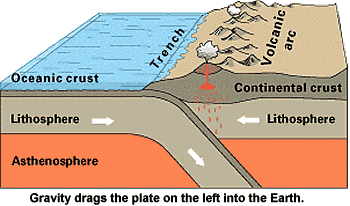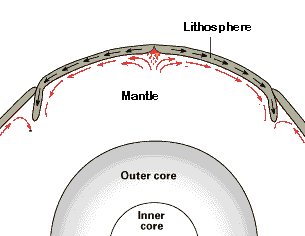BACKGROUND:
According to the theory of plate tectonics, the
Earth's crust and upper mantle are broken into moving plates. The
lithospheric plates are solid rock. There are several very large plates,
each consisting of both oceanic and continental portions. There are a dozen
or more smaller plates. The plates average about 80 kilometers (50 miles) in
thickness. All of the plates are moving. They are slow, moving at speeds of
centimeters to tens of centimeters per year. They slide along on top of an
underlying mantle layer called the asthenosphere, which is composed of a
rock that is fluid-like.
Geologists have distinguished three main internal
subdivisions of the Earth, based on the behavior of seismic waves and
laboratory experiments. The outermost layer is the crust. Underlying the
crust is the second layer, the mantle. It comprises the largest portion of
the Earth. Like the crust, it is also composed of silicate minerals. The
innermost portion of the Earth is the core. It is composed of metallic
elements, primarily iron and nickel. The core is subdivided into two parts.
The outer core is liquid metal, while the inner core is solid.
Volcanoes and earthquakes help define the boundaries
between the plates. Volcanoes form mostly at converging and diverging plate
boundaries, where much magma is generated. Earthquakes occur at all three
types of boundaries. Because the plates are rigid, they tend to stick
together, even though they are constantly moving. When the strength of the
rocks at the plate boundary is exceeded, they move rapidly, "catching
up" with the rest of the plates. We feel this release of energy as an
earthquake.
Many lines of evidence indicate that the plates are
moving. What is less clear, however, is why the plates move. There are two
main scientific ideas for explaining plate movement: gravity and convection
currents. All objects on and in the Earth are pulled towards its center by
the force of gravity. This may effect the plates at converging plate
boundaries in areas called subduction zones, where one plate sinks into the
mantle. This is shown in the left picture below. Some evidence suggests that
gravity pulls the sinking plate down. The rest of the plate is dragged along
behind it. This is physically similar to slowly pushing a piece of paper off
a  table; it
eventually bends, and slides off, pulling the rest of the paper behind it.
table; it
eventually bends, and slides off, pulling the rest of the paper behind it.
The other reason for plate motion relates to
convection currents within the upper part of the mantle. Convection is the
heat-driven circulation of a fluid. The inside of the Earth is much hotter
than its surface. Heat thus moves from the interior towards the surface. In
the mantle, heat from deeper in the Earth causes the overlying mantle to
circulate. The mantle can circulate because it contains a little magma
(molten rock); it is a very hot, thick (viscous) fluid. Mantle convection
currents move very, very, slowly. It is possible that as the mantle convects,
it drags the overlying plates along with it. Where convection currents come
together, a converging plate boundary is present. Where they move apart, a
diverging plate boundary forms. An example is shown above. This picture
portrays convection of the entire mantle, but it some scientists think that
is more likely that just the upper part of the mantle convects. Convection
and gravity contribute to the movement of the plates.
PROCEDURE:
-
 This unit
reinforces the concept that the movements within the Earth cause stress
in the plates. Most of the stress is caused by movement with the Earth
and gravity. A portion is also due to external forces such as the Earth’s
rotation.
This unit
reinforces the concept that the movements within the Earth cause stress
in the plates. Most of the stress is caused by movement with the Earth
and gravity. A portion is also due to external forces such as the Earth’s
rotation.
-
Draw the diagram on the board. Discuss the crust, mantle, outer core,
and inner core. These terms are discussed in the Earthquakes portion of
the Plate Tectonic Cycle.
-
Prepare the students to think about what lies inside of the Earth.
Have them guess how we know what is inside of the Earth. Many of the
students will think we can drill deep into the Earth, but we can not. We
cannot even drill through the crust. Refresh their memories on seismic
waves from the previous unit on Earthquakes. Scientists use variations
in the speed and behavior of seismic waves to distinguish the different
parts of the Earth’s interior.
-
Explain the meaning of converging, diverging, and transform plate
motion to the class.
-
Draw the diagram below. Ask the students where the stress is. In the
diverging picture it is near the pull-apart area; in the converging
picture it is where the plates bump; and in the transform motion picture
it is where the plates are slipping past each other.